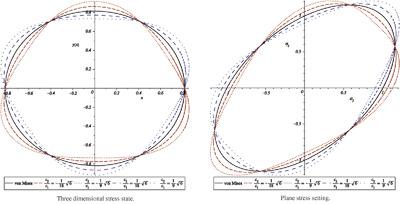Our official English website, www.x-mol.net, welcomes your feedback! (Note: you will need to create a separate account there.)
A micro‐mechanically motivated phenomenological yield function for cubic crystal aggregates
ZAMM - Journal of Applied Mathematics and Mechanics ( IF 2.3 ) Pub Date : 2020-05-15 , DOI: 10.1002/zamm.202000061 Alexander Dyck 1 , Thomas Böhlke 1
ZAMM - Journal of Applied Mathematics and Mechanics ( IF 2.3 ) Pub Date : 2020-05-15 , DOI: 10.1002/zamm.202000061 Alexander Dyck 1 , Thomas Böhlke 1
Affiliation

|
A micro‐mechanically motivated phenomenological yield function, for polycrystalline cubic metals is presented. In the suggested yield function microstructure is taken into account by the crystallographic orientation distribution function in terms of tensorial Fourier coefficients. The yield function is presented in a polynomial form in powers of the stress state. Known group‐theoretic results are used to identify isotropic and anisotropic parts in the yield function, whereby anisotropic parts are characterized by tensorial Fourier coefficients. The form of the presented yield function is inspired by the classic, phenomenological von Mises ‐ Hill yield function first published in 1913. For a specific choice of material parameters, both functions coincide, thus a micro‐mechanically motivated generalization of the von Mises ‐ Hill yield function is presented. For the given yield function, two dimensional experimental results are sufficient, to identify a three dimensional anisotropic yield behavior. The work concludes with a treatment of the isotropic special case, i.e. a tension‐compression split in yield behavior as well as parameter ranges for convexity and shapes of the yield surface.
中文翻译:

立方晶体聚集体的微机械动力现象学屈服函数
提出了多晶立方金属的微观力学现象学的屈服函数。在建议的屈服函数中,通过张量傅立叶系数的晶体取向分布函数考虑了微观结构。屈服函数以应力状态的幂的多项式形式表示。已知的群理论结果用于确定屈服函数中的各向同性和各向异性部分,其中各向异性部分由张量傅里叶系数表征。提出的屈服函数的形式受到1913年首次发表的经典现象学冯·米塞斯·希尔屈服函数的启发。对于特定的材料参数选择,两个函数重合,因此,提出了冯·米塞斯·希尔屈服函数的微机械驱动的概括。对于给定的屈服函数,二维实验结果足以确定三维各向异性屈服行为。这项工作以各向同性的特殊情况作为结束,即屈服行为中的拉伸-压缩分裂以及屈服面的凸度和形状的参数范围。
更新日期:2020-05-15
中文翻译:

立方晶体聚集体的微机械动力现象学屈服函数
提出了多晶立方金属的微观力学现象学的屈服函数。在建议的屈服函数中,通过张量傅立叶系数的晶体取向分布函数考虑了微观结构。屈服函数以应力状态的幂的多项式形式表示。已知的群理论结果用于确定屈服函数中的各向同性和各向异性部分,其中各向异性部分由张量傅里叶系数表征。提出的屈服函数的形式受到1913年首次发表的经典现象学冯·米塞斯·希尔屈服函数的启发。对于特定的材料参数选择,两个函数重合,因此,提出了冯·米塞斯·希尔屈服函数的微机械驱动的概括。对于给定的屈服函数,二维实验结果足以确定三维各向异性屈服行为。这项工作以各向同性的特殊情况作为结束,即屈服行为中的拉伸-压缩分裂以及屈服面的凸度和形状的参数范围。


























 京公网安备 11010802027423号
京公网安备 11010802027423号